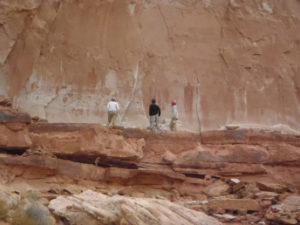 As a kid, I thought a lot about quicksand. After watching The Princess Bride, I assumed it would be an inevitable problem I would have to address in adulthood. Before coming here, I did not employ any knowledge I’d acquired about how to deal with sinking in quicksand. Turns out, though, quicksand does exist in real life! It exists here on the Colorado Plateau! It’s not in random places, it doesn’t slowly swallow you or get worse if you struggle. It happens to be very different from any cinematic portrayals of it, as things tend to be. But it’s here. It exists in or next to streambeds, and doesn’t get very deep. If you position your weight right, it ripples under your feet. The best way I can explain it is that it’s like walking on jello, but if you stand still it’ll try to eat your feet. Pretty neat stuff.
As a kid, I thought a lot about quicksand. After watching The Princess Bride, I assumed it would be an inevitable problem I would have to address in adulthood. Before coming here, I did not employ any knowledge I’d acquired about how to deal with sinking in quicksand. Turns out, though, quicksand does exist in real life! It exists here on the Colorado Plateau! It’s not in random places, it doesn’t slowly swallow you or get worse if you struggle. It happens to be very different from any cinematic portrayals of it, as things tend to be. But it’s here. It exists in or next to streambeds, and doesn’t get very deep. If you position your weight right, it ripples under your feet. The best way I can explain it is that it’s like walking on jello, but if you stand still it’ll try to eat your feet. Pretty neat stuff.
In addition to quicksand, some other things that exist out here include: a cave with the softest and finest sand I’ve ever touched (think—a mountain of powdered sugar), more snow and rain than anyone anticipated in the desert, pack rat middens (Google these. Just do it.), fossil fuels buried deep in the older layers of the canyon that are hundreds of millions of years old, 22 archeological sites per square mile in the Dirty Devil River Canyon, and (getting to the point) evidence of the complex lives of the people who lived here thousands of years ago.
The Ancient Pueblos, inhabited these lands long before Europeans even realized this continent existed. They were here being born and living and loving and dying before my ancestors were even intelligent enough to correctly measure the circumference of the Earth. This thought has been in my brain since we first saw evidence of their lives here at the Great Gallery in Horseshoe Canyon. Scholars and children alike have speculated the significance of this place. Something I find incredible is that they are all right at once. Without any of these ancient people alive to tell us, there is no way for us to know what exactly that great panel is there for. This means that your guess is as good as mine.
We have also seen granaries and even more artwork by these people while hiking down the Dirty Devil River. We’ve found their tools—cutting rocks and arrowheads made out of colorful chert. We have found a place where they carved and shaped these. We read about their lifestyles of hunting and gathering transitioning to agriculture. We have imagined their lives, though attempting to comprehend their complexity has proved difficult.
But I think it’s important to ponder these complexities. It is important to imagine these ancient people in such a way that they actually become people. No more or less. Simply a people of a different time, but still humans who felt the spirit of this landscape, just as we have walking through it. These things are important because they connect us. They shape these people, not into the mythical beings they are sometimes imagined as, but as humans just like all of us.
We have been reading chapters out of a book called Resilience Thinking. This type of thinking means exploring all parts of a system, not optimizing one and discounting the rest. Not focusing on attention on a single thing, but rather trying to understand that the world is more complex than we give it credit for. This kind of thinking is necessary when exploring and imagining the lives of ancient peoples. Like I said before, they are humans. This landscape affected them in many of the same ways it affects us. Their thoughts were just as meaningful as ours, as were their beliefs. The way they lived may have been different, but essentially the things that come to matter to us, like the people we love and the places we live, are the same. Resilience thinking allows us to see this and study these people with open minds and open spirits.
Quicksand exists. I know this now. I know that there is sand softer than anything I’ve ever touched. I know how hard it is to walk 10 miles with your life on your back. And I know, in a much more intimate way than I ever could have without coming here, what the lives of these ancient peoples might have been like. And the best part is that they have descendants. And we are about to go meet them. Here we come, Hopi and Navajo nations. I will be blogging about you.